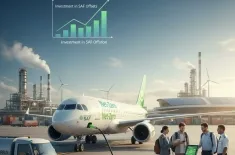Discover smart luggage and real-time baggage tracking solutions
The modern travel experience, while often exciting, is frequently accompanied by a persistent undercurrent of anxiety, particularly surrounding checked luggage. The fear of lost or delayed bags is a tangible stressor that affects millions of passengers annually. However, the confluence of smart luggage and advanced real-time baggage tracking technologies is rapidly transforming this landscape, moving from a system of uncertainty to one of constant, accurate location data. This revolution is powered by the Internet of Things (IoT), embedding intelligence into our bags and creating a truly connected travel ecosystem. The widespread adoption of these solutions promises not only to alleviate traveler anxiety but also to usher in an era of seamless airport logistics and highly efficient asset monitoring.
The Technological Core: How Smart Tracking Works
The ability to track a bag anywhere in the world stems from sophisticated micro-electronics embedded within the luggage itself or as a specialized IoT luggage tag. These devices leverage a combination of wireless communication technologies to ensure global coverage and precise positioning. The primary technologies involved are:
Global Positioning System (GPS)
GPS is the backbone for providing wide-area, global location data.
- Function: A GPS module within the smart device receives signals from multiple satellites orbiting the Earth. By calculating the time difference of arrival of these signals, the device can accurately triangulate its precise location, often down to a few meters.
- Application in Luggage: For a piece of luggage, the GPS coordinates (latitude and longitude) are the core data point for international tracking. This data is then transmitted to the user's mobile application via cellular networks (GSM/GPRS) or a dedicated low-power wide-area network (LPWAN).
- Benefit: This provides travelers with constant, accurate location data regardless of where the bag is in transit, whether it’s in the belly of an aircraft or at an international transfer hub.
Bluetooth and Beacons
While GPS is ideal for global tracking, Bluetooth and beacons excel at highly localized, short-range tracking, often in indoor environments like airport terminals.
- Beacons (Bluetooth Low Energy - BLE): These are small, low-cost hardware transmitters installed strategically throughout an airport or within a tracking device. They broadcast a unique identifier signal periodically.
- Function: A smart luggage tag (or a personal device like an Apple AirTag or Samsung SmartTag) uses its Bluetooth radio to 'hear' these signals. When a passenger's bag comes within range of a beacon or another Bluetooth-enabled device (like an airline employee's scanner or another traveler’s phone in a crowd-sourced network), its presence is registered.
- Application in Luggage: In the final stages of the journey—such as at baggage claim, a transfer carousel, or even within the airport's loading area—Bluetooth is highly effective. It allows the traveler to precisely locate their bag once they are nearby, reducing the anxious wait at the carousel.
Radio Frequency Identification (RFID)
RFID is primarily an operational tool used by airports and airlines for highly automated, high-speed tracking.
- Function: An RFID system consists of a tag, which holds digital data, and a reader. The reader emits radio waves that activate the tag, allowing the data to be read without a direct line of sight.
- Application in Luggage: Airlines are increasingly implementing RFID tags into baggage labels. As a bag moves through the conveyor system, security checkpoints, and loading bridges, fixed RFID readers automatically scan the tag, instantly updating its location in the airline's system.
- Benefit: RFID dramatically increases the read rate accuracy (often approaching 100%) compared to traditional barcode scanning, directly contributing to seamless airport logistics and a significant reduction in mishandled bags.
Beyond Location: Smart Luggage Features
The concept of smart luggage extends beyond mere location finding, integrating a suite of features that enhance convenience, security, and compliance.
Integrated Weight Sensors
Many smart suitcases include built-in digital scales. This feature allows travelers to weigh their bag before leaving for the airport, preventing unexpected overweight baggage fees and ensuring compliance with airline regulations.
Digital Locking and Biometric Security
Some high-end smart bags offer TSA-approved digital locks that can be opened via a smartphone app or a biometric fingerprint scanner. This provides an additional layer of security beyond traditional combination locks.
Power Banks
A key feature of early smart bags was the integrated, often removable, power bank to charge mobile devices. This keeps a traveler's phone charged, which is essential for receiving real-time baggage tracking updates.
Proximity Alerts
Using Bluetooth technology, a smart luggage app can send a proximity alert to the traveler's phone if the bag moves a certain distance away from them, which is useful for preventing theft or accidental separation in busy areas.
The Impact on the Traveler Experience
The most profound impact of these tracking solutions is the elimination of the "information black hole" that traditionally occurred between check-in and arrival. The result is a radically improved passenger experience.
Reducing Anxiety and Loss
For the traveler, the ability to monitor their belongings turns passive waiting into informed anticipation. If a bag is accidentally loaded onto the wrong aircraft, the passenger can see its last known location and instantly notify the airline with precise data, significantly expediting recovery. This direct visibility acts as a powerful antidote to anxiety, providing the peace of mind that comes from knowing the bag's whereabouts at all times.
Empowered and Connected Travel
These solutions are a cornerstone of connected travel. Travelers are no longer dependent solely on airline updates; they are active participants in their bag’s journey. This empowerment fosters a greater sense of control and trust in the system. The mobile app serves as the single point of truth, offering:
- Real-time updates on the bag’s status (checked-in, in transit, on the carousel).
- Estimated Time of Arrival (ETA) to the baggage claim.
- Alerts for any unexpected delays or diversions.
Operational Revolution: Seamless Airport Logistics
From the perspective of airports and airlines, smart tracking technology is an unparalleled tool for operational efficiency and compliance.
Meeting IATA Resolution 753
The International Air Transport Association (IATA) Resolution 753 mandates that airlines must track a bag at four mandatory points:
- Check-in
- Aircraft loading
- Transfer (if applicable)
- Arrival for delivery to the passenger
Technologies like RFID and integrated baggage systems (like SITA's WorldTracer and Bag Journey) make compliance with Resolution 753 highly automated and efficient. This focus on asset monitoring at every critical juncture is the mechanism for dramatically reducing the industry's rate of mishandled baggage.
Enhanced Asset Monitoring and Data Analytics
The vast amount of data generated by tracking devices—where bags move fastest, where bottlenecks occur, how long transfers take—provides airports and airlines with invaluable insights.
| Metric | Traditional System (Barcode) | Smart Tracking (RFID/IoT) |
|---|---|---|
| Read Accuracy | Varies, susceptible to damage | Near 100% (non-line-of-sight) |
| Data Visibility | Limited to fixed scan points | Real-time, continuous monitoring |
| Logistics Improvement | Reactive, error-prone | Proactive, data-driven seamless airport logistics |
This data allows for predictive modeling, enabling ground staff to make proactive adjustments, optimize baggage routes, and improve the entire handling ecosystem, resulting in lower operational costs.
Challenges and Regulatory Hurdles
Despite the clear benefits, the widespread adoption of smart tracking has faced specific challenges, primarily related to power sources.
Lithium Battery Regulations
Airlines worldwide, including the Federal Aviation Administration (FAA) and IATA, imposed restrictions on smart luggage containing non-removable lithium-ion batteries.
- The Hazard: Lithium-ion batteries pose a fire risk, especially in the cargo hold.
- The Rule: If a bag is checked, the battery must be removable. If the battery is removable, it must be taken out and carried on in the cabin. If a bag is carried on, the battery can typically remain installed, but the device must be powered off.
This regulation directly forced manufacturers to redesign their smart luggage to ensure battery compliance, accelerating the shift toward simpler, standalone IoT luggage tags that use smaller, non-rechargeable or lower-risk batteries.
The Future of Connected Travel
The next evolution of real-time baggage tracking will see further integration and data sharing. As more airlines and airports adopt standardized tracking technologies—particularly RFID and open APIs for sharing personal tracker data (like Delta Air Lines' integration with Apple AirTag data)—the vision of true seamless airport logistics will be fully realized.
The ultimate goal is a fully automated, predictive ecosystem where baggage is never truly "lost," only temporarily rerouted. For the traveler, the assurance provided by constant asset monitoring transforms the airport experience from one of anxious waiting to confident, connected travel. The smart luggage revolution is not just about a better suitcase; it's about a better, more secure, and less stressful way to travel the world.



































